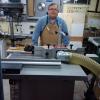Hey all, I am almost finished with my 14" Jet refurbishment saga and have come to the final step; cleaning and finishing the table. When I bought the bandsaw, it was sitting in a gentleman's unconditioned shed and since our summers here in NC are pretty humid, you can imagine the rust on the table top. It had sat for so long, that the table under where the miter gauge had rested, was almost immaculate. However the rest of the table was coated rust with minor pitting. What I have done so far, used a nylon bristle brush to remove portion of rust, then utililzed BarKeeper's friend for the next step, which worked great. In fact the smell reminded me of the Rust free stuff I have that is made by Boeshield. From there I used a copper wire brush on my drill to clean it up even more. Last night I threw a 120 grit sanding pad then a gray Scotch Brite pad on my ROS and went to town. That worked pretty well. I am happy with the smoothness I have, and the rust is gone for the most part, except the stains. My question is two fold, 1) should I move to 220 grit to sand the top? 2) Also, is there any way to remove the stains? It is very usable now, but I want to get it as good as I can before I seal it with wax. I read somewhere to use a hair dryer or heat gun to melt it in before buffing it out. Anyone done that? Thanks for your response!





 Reply With Quote
Reply With Quote








